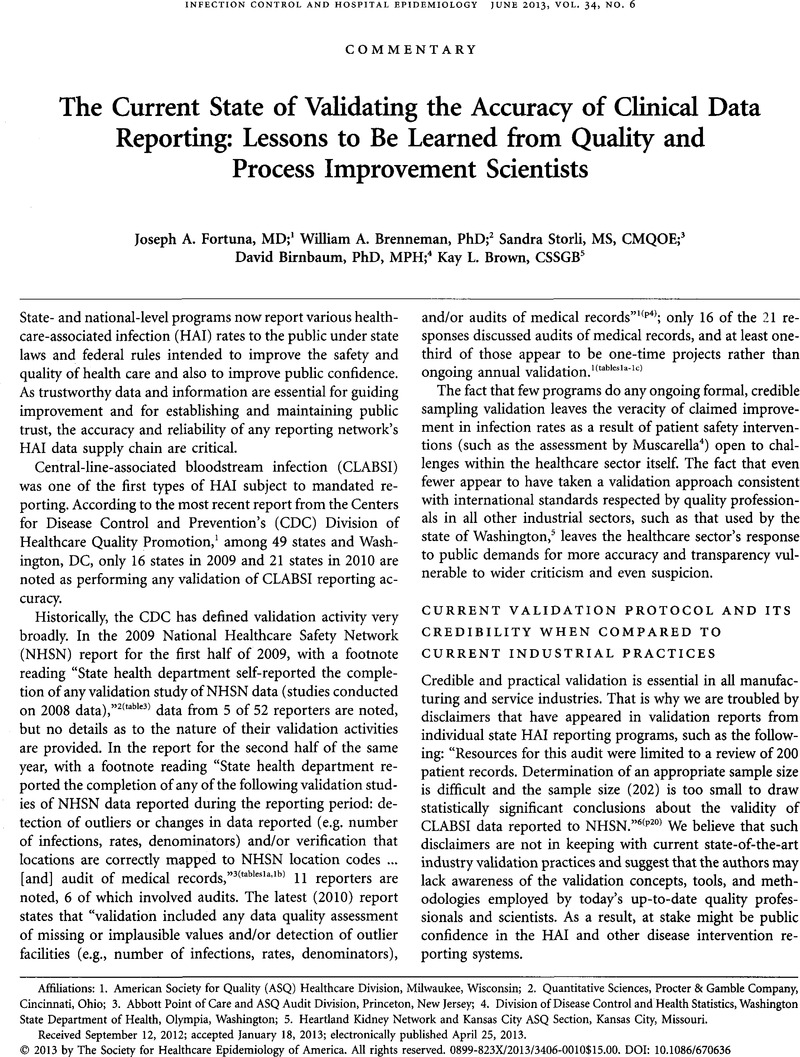Crossref Citations
This article has been cited by the following publications. This list is generated based on data provided by Crossref.
Birnbaum, David
2015.
SHEA’s White Paper on Electronic Surveillance Data Requirements.
Infection Control & Hospital Epidemiology,
Vol. 36,
Issue. 1,
p.
114.
Mathur, Purva
2015.
Surveillance systems for health care associated infections.
Journal of Patient Safety & Infection Control,
Vol. 3,
Issue. 1,
p.
4.
Birnbaum, David
2016.
Buyer beware: health choices information broadcast to the public.
International Journal of Health Governance,
Vol. 21,
Issue. 1,
p.
35.
Fakih, Mohamad G.
Gould, Carolyn V.
Trautner, Barbara W.
Meddings, Jennifer
Olmsted, Russell N.
Krein, Sarah L.
and
Saint, Sanjay
2016.
Beyond Infection: Device Utilization Ratio as a Performance Measure for Urinary Catheter Harm.
Infection Control & Hospital Epidemiology,
Vol. 37,
Issue. 3,
p.
327.
Lempp, Jason M.
Cummings, M. Jeanne
and
Birnbaum, David W.
2017.
Distribution of Central Line-Associated Bloodstream Infections Determined From Washington State’s Annual Reporting Validation Program, 2009–2013.
Infection Control & Hospital Epidemiology,
Vol. 38,
Issue. 4,
p.
489.
Patel, Anup D.
Herbst, James
Gibson, Annika
Karn, Mary
Terry, Debbie
Debs, Andrea
Yarosz, Shannon
Parker, William
and
Cohen, Daniel M.
2020.
Using quality improvement to implement the CNS/AAN quality measure on rescue medication for seizures.
Epilepsia,
Vol. 61,
Issue. 12,
p.
2712.
Patel, Anup D.
Debs, Andrea
Terry, Debbie
Parker, William
Burch, Mary
Luciano, Debra
Patton, Lauren
Brubaker, Jena
Chrisman, Julie
Moellman, Kathy
Herbst, James
and
Cohen, Daniel M.
2021.
Decreasing Emergency Department Visits for Children With Epilepsy.
Neurology Clinical Practice,
Vol. 11,
Issue. 5,
p.
413.
Vidaurre, Jorge
Albert, Dara V. F.
Parker, William
Naprawa, Jim
Mittlesteadt, Jackson
Idris, Ali‐Shan
and
Patel, Anup D.
2021.
Improving time for administration of second‐line antiseizure medications for children with generalized convulsive status epilepticus using quality improvement methodology.
Epilepsia,
Vol. 62,
Issue. 10,
p.
2496.
Mytinger, John R.
Parker, William
Rust, Steven W.
Ahrens, Stephanie M.
Albert, Dara V.F.
Beatty, Christopher W.
Chrisman, Julie
Clark, Daniel J.
Debs, Andrea
Denney, Danielle
Karn, Mary
Herbst, James
Ostendorf, Adam P.
Taylor, Mary C.
Twanow, Jaime D.E.
Vidaurre, Jorge
and
Patel, Anup D.
2022.
Prioritizing Hormone Therapy Over Vigabatrin as the First Treatment for Infantile Spasms.
Neurology,
Vol. 99,
Issue. 19,
Set, Kallol K.
Bailey, Jason
and
Kumar, Gogi
2022.
Reduction of No-Show Rate for New Patients in a Pediatric Neurology Clinic.
The Joint Commission Journal on Quality and Patient Safety,
Vol. 48,
Issue. 12,
p.
674.
Gumayan, Rae Leonor
Parker, William
Gunduz, Muhammed Talha
Aylward, Shawn C.
Auer, Nancy
Albert, Dara V.F.
and
Patel, Anup D.
2024.
Increasing Provider Utilization of a Seizure Action Plan in the Outpatient Setting.
Pediatrics,
Vol. 154,
Issue. 1,
Morgan, Brandon
Weisleder, Pedro
Patel, Anup D.
Parker, William
Rose, Megan
and
Butz, Catherine
2024.
Screening for Quality of Life in a Neurology Tic Clinic Using Quality Improvement Methodology.
Pediatric Neurology,
Vol. 155,
Issue. ,
p.
44.



